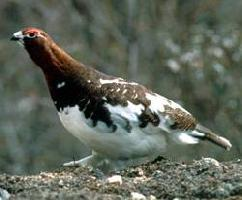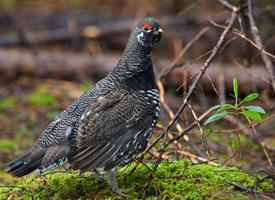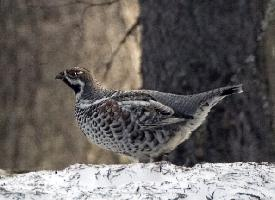
Descrierea animalului
The Willow Ptarmigan (Lagopus lagopus), also known as the Willow Grouse, is a fascinating bird species that belongs to the grouse family. It is notable for being the state bird of Alaska and is renowned for its remarkable adaptations to cold environments, including its seasonal color change. This bird has a circumpolar distribution, inhabiting the tundra and boreal forests of northern Europe, Asia, and North America, including Alaska and Canada. Its ability to thrive in such cold climates is a testament to its evolutionary success and specialized adaptations.One of the most striking features of the Willow Ptarmigan is its seasonal plumage change. In the summer, its feathers are a mixture of brown, black, and gray, which allows it to blend seamlessly into the surrounding tundra and forest landscapes. This camouflage helps it to avoid predators while nesting on the ground and foraging for food. As winter approaches, the bird undergoes a dramatic transformation, with its plumage turning completely white except for its tail, which remains black. This winter camouflage is crucial for its survival, as it makes the bird almost invisible against the snow, protecting it from predators.
The Willow Ptarmigan is a medium-sized bird, with males being slightly larger than females. It has a stocky build, rounded wings, and a feathered beak, which helps to minimize heat loss. One of its most distinctive adaptations to cold weather is its feathered feet, which act like snowshoes to support the bird on soft snow and insulate its feet from the cold.
Diet-wise, the Willow Ptarmigan is omnivorous but primarily feeds on plant material. During the summer, its diet consists mainly of leaves, flowers, and berries. In the winter, when vegetation is scarce, it feeds on twigs and buds of willow and birch, which is where it gets its name. This ability to switch diets according to season is crucial for its survival in the harsh Arctic environment.
Breeding typically occurs in the spring, with males becoming highly territorial and performing elaborate displays to attract females. The female lays a clutch of 6-10 eggs in a ground nest, which she incubates for about three weeks. Once hatched, the chicks are precocial, meaning they are relatively mature and mobile from the moment of birth. They are able to feed themselves, but the mother leads them to food sources and protects them from predators.
In terms of social behavior, the Willow Ptarmigan is known for its vocalizations, especially during the breeding season. Males emit a variety of sounds, including a guttural croaking and a loud "go-back, go-back" call to defend their territory and attract mates. Outside of the breeding season, these birds can be found in flocks, which helps them to detect predators and locate food sources.
Conservation-wise, the Willow Ptarmigan is currently not considered to be at risk. Its wide distribution and ability to adapt to its environment have ensured its survival. However, like many Arctic species, it may face challenges from climate change, which could alter its habitat and food sources.
In summary, the Willow Ptarmigan is a remarkable bird that has adapted well to the extreme conditions of the Arctic. Its seasonal plumage change, dietary flexibility, and social behaviors are just a few of the traits that make it an interesting subject of study for ornithologists and nature enthusiasts alike. Its presence across the northern latitudes serves as a reminder of the resilience and adaptability of wildlife in some of the planet's most challenging environments.
Animale similare
Fotografii noi cu animale
Top 10 animale
- Diana monkey (Cercopithecus diana)
- Dolphin gull (Leucophaeus scoresbii)
- Galápagos tortoise (Geochelone nigra complex)
- Moustached guenon (Cercopithecus cephus)
- Japanese spider crab (Macrocheira kaempferi)
- Colossal squid (Mesonychoteuthis hamiltoni)
- Fox tapeworm (Echinococcus multilocularis)
- Stone loach (Barbatula barbatula)
- Japanese macaque (Macaca fuscata)
- Barbary macaque (Macaca sylvanus)


